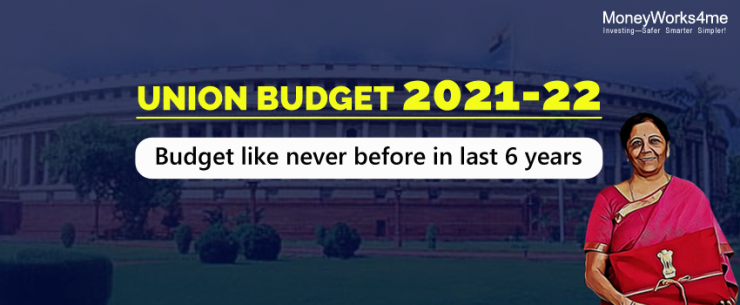Every crisis forces the government’s hand to put the economy back on its feet. This year’s budget following the pandemic crisis was nothing short of it.
This article covers the following:
On February 1st, 2021, Hon. Finance Minister Nirmala Sitharaman presented Budget 2021-22. On the face of it, nothing negative was good news for the stock market.
It was remarkable in the sense that the government chose to go aggressive to create a favorable environment for the economy to recover and thrive. The commitment of the government to revive the economy is seen by a budgeted estimate of a 6.8% fiscal deficit in FY22. This follows the 9.5% fiscal deficit seen for the year FY21.
Not just that, the glide path for fiscal deficit indicates strong expansionary policy for few years, with a fiscal deficit going below 4.5% only in FY26. This was a pleasant surprise for the markets with the Nifty closing 4.75% higher for the day.
The NK Singh committee – constituted by the Narendra Modi government – recommended a fiscal glide path for the government that would have gradually brought down the fiscal deficit to 3 percent of GDP by the end of FY20 and further reduced it 2.5 percent by FY23. Now with Covid’s slowdown hitting the country, the government changed its stance to grow the economy through investments.
Key numbers from the budget speech:
- Budget expenditures same as previous year ~Rs 34L Cr.
- Capital expenditures increased to Rs 5.54L Cr vs Rs 4.1L Cr in the previous year (+35%).
- PLI schemes to make India’s manufacturing exporter worth Rs 1.97L crore over the next 5 years.
- Rs 1.1L Cr each for Roads and Railways, both investments for new infrastructure.
- No changes in the direct tax rate, personal or corporate.
- Rs 3L Cr towards discoms for modernization and infrastructure.
- Divestment worth Rs 1.74L Cr from the privatization of government-owned companies.
- Development Finance Institution with Rs 20k Cr capital set up for raising Infra funds.
- Rs 20k Cr for PSU Bank recapitalization.
Category wise budget announcements:
Healthcare
137% increase in Health and Well being including healthcare spend to Rs 2.3L Cr. This includes Covid Vaccine worth Rs 35k Cr and water sanitation. This is positive for availing healthcare and reduces out of pocket expenses of the lower-income category. Low-cost hospitals and Diagnosis centers will benefit from increasing awareness of health and diagnosis.
Infrastructure
The government has already announced projects worth Rs 10L Cr during 2019. Out of which, Rs. 1.1L Cr is completed. The government will set up a development finance company to raise funds for future infrastructure projects.
The budget also highlights fundraising via monetization of existing infrastructure assets like NHAI, Grids, and Gas pipeline.
Large spends on Dedicated Freight Corridor (DFC). Western DFC (Delhi to JNPT) to become operational in Jun-22 and Eastern DFC (Delhi to Howrah). DFC is a high-speed freight-only rail track for timely and cost-effective transport. It connects Ports with the hinterland for goods transportation. It will save time and resources thereby adding to the productivity of the economy.
Investment in City Gas and Gas pipeline to increase the share of Gas in overall fuel consumption.
Textiles and Manufacturing:
Existing announcement of new manufacturing plants attracting 15% in income tax. In addition to it, the PLI scheme is announced for exports to provide performance-based incentives. Manufacturing companies have large potential from western countries moving away from China to de-risk dependency on a single country. Alongwith PLI for textile exporters, textile parks will be set up dedicated to exports. The textile industry provides a large employment generation. Export-oriented textiles are beneficiaries.
Automobile
Scrappage policy for Commercial Vehicles and Passenger Vehicles and purchases of buses for government organizations.
In a nutshell, it was a more opportunistic budget when global economies are also running large deficits. Bond investors may get more cautious looking at increasing glide path for the fiscal deficit but it certainly is one leg up for equity markets in long term.
What are some big ideas for the next 5 years?
Over the next 5 years, we believe that the focus of the market will shift to sectors like Infrastructure, Capital Goods and Manufacturing, Domestic and Exports. We had anticipated it in the year FY19-20 but looks like it’s coming true now, better late than never.
We find two types of companies worth participating in, i) contractors to other private infrastructure companies (Capital goods, Contract mfg or EPC contractors) and ii) asset owners expanding assets into new geographies (Generators, distributors, Pipelines, Ports, etc.)
Ancillary companies supplying to infrastructure companies will also benefit from capacity expansion in infrastructure. Eg. Rail Bearings, Cement, Industrial Paints, Refractories, Abrasives, etc.
The banking sector is another beneficiary that will enjoy growth as it will fund the value chain of infrastructure companies.
What is meant by the Union budget?
Union Budget is a comprehensive report of the Government’s finances in which revenues from all sources and expenditures for all activities are presented. Union Budget lays down the statement of the estimated receipts and expenditures of the government for the coming financial year. It sets out how the government proposes to allocate the financial resources among the various agencies that make claims on it and how it proposes to raise the finances for this.
Who prepares the Union Budget?
The budget is made through a consultative process involving the Ministry of Finance, NITI Aayog, and spending ministries. Finance ministry issues guidelines to spend based on which ministries present their demands. The Budget Division of the Department of Economic Affairs in the finance ministry is the nodal body responsible for producing the Budget.
Why is the Union Budget Important?
In a democracy like India, the government cannot arbitrarily spend, borrow, or tax money. So, for the government to function effectively and help improve the economic and social framework of the country, budgeting and planning is a necessity. Union budget ensures Resource Allocation, Price Control, and Reducing Economic Inequality.
What is the income tax slab for 2021-22?
There is no change to the income tax rate or income tax slab for FY2021-22.
How much we can save under 80C in 2021-22?
There are no changes in tax deductions for Budget 2021-22. You can save Rs. 46,800/- under section 80C by investing 1,50,000. One can additionally save 15,000 by investing in National Pension System.
What is the total budget of India in 2021-22?
The total Budget for the year 2021-22 is around Rs. 34 Lakh Crores. The budget is equal to the total expenditures committed by the government.
Is Union Budget 2021 good or bad?
Budget 2021-22 was cheered by the market as it reflected high investments will be made by the government to revive the economy. While it was good for a few sectors, for others it was neutral. Overall, Budget 2022 was more positive than negative.
What are the 3 types of budgets?
Budgets are of 3 types – Balanced budget, Surplus budget, and Deficit budget. A government budget is said to be a deficit budget if the estimated government expenditure exceeds the expected government revenue in a particular financial year. A deficit budget is best suited for developing economies like India.
Annual Financial Statement
Annual Financial Statement is a document presented to Parliament as part of the Budget, as per the Constitution of India. The documents consist of receipts and expenditures of the government in the current year, previous year, and the Budget year.
Balance of payments (BoP)
Balance Of Payment (BOP) is a record of all the monetary transactions made by a country’s population and the rest of the world in a given period. It includes all flows of residents, government, and corporates.
Budget Estimates
Every financial year, the government has to disclose in a budget speech the funds allocated for various projects and activities and ministries are laid out. These numbers are called Budget estimates.
Capital Budget
Capital Budget consists of capital receipts (like funds from divestment, borrowing, loans from RBI, etc) and capital expenditure (loan repayment, capital infusion in government enterprises, etc.)
Capital Expenditure
Capital Expenditures involves capital spends by the government. It uses capital to infuse funds into public enterprises for growth/expansion, fund infrastructure fund or loan repayments.
Capital Receipts
To meet the Capital Expenditure of each year, the government has to raise funds from the market, RBI, or divestment of its existing assets. This is called Capital Receipts.
Cess
A cess is a form of tax meant for specific purposes till the time the government raises money for a particular purpose. It might be temporary in nature or permanent but it differs from taxes and duties like excise and personal income tax.
Corporate Tax
A corporate tax is a tax levied on the profits of a corporation. A corporation may have a different tax structure based on size or sector.
Current Account Deficit (CAD)
Current Account is a record of the country’s transactions with other nations, in terms of trade of goods and services, net of earnings in other nations as well as remittances.
Current Account Deficit or CAD is the shortfall between the money flowing in on exports, and the money flowing out on imports. Current Account Surplus means excess flows from exports over spends from imports.
Customs Duty
Customs Duty is a tax imposed on imports and exports of goods. It can be fixed or a percentage of the value of the goods.
Direct and Indirect Taxes
Direct taxes are levied on income and profits. Indirect taxes are levied on the manufacturing of goods or delivery of services. Indirect taxes on a large set of goods and services is now called Goods and Services Tax.
Disinvestment
Disinvestment means the sale or liquidation of assets by the government, usually Central and State public sector enterprises.
Dividend Distribution Tax (DDT)
Dividend Distribution Tax (DDT) is a tax levied on dividends paid out by companies out of their profits among their shareholders. The Dividend Distribution Tax is taxable at source and is deducted at the time of the distribution. As per Budget 2021, dividends are now taxed in hands of shareholders.
Economic Survey
Economic Survey highlights economic trends in the country and helps in the planning of resources allocation in the Union Budget.
Fiscal Deficit
Fiscal Deficit is the difference between the total income of the government, total taxes and capital receipts, and total expenditure.
Fiscal Policy
Fiscal policy using the government budget to finance economic expansion or contraction. In expansionary policy, the government spends more, in form of infrastructure or provides a regular income in hands of citizens, or lowers the tax rate. This helps in kicking animal spirits and the start of an economic cycle. On the other hand, if the economy is overheated and causing inflation, the government decreases spending or raises taxes. This is called contracting fiscal policy.
Gross Domestic Product (GDP)
Gross Domestic Product GDP is the total value of goods and services produced in a country. This includes consumption, government expenditures, and investments from the government and private sector. It includes exports but excludes Imports. GDP formula Consumption + Government Expenditures + Govt. & Private investments + Exports – Imports. GDP= C+G+I+Ex-Im
Gross National Product (GNP)
Gross national product (GNP) is an estimate of the total value of all the final products and services turned out in a given period by the means of production owned by a country’s residents. GNP is commonly calculated by taking the sum of personal consumption expenditures, private domestic investment, government expenditure, net exports, and any income earned by residents from overseas investments, minus income earned within the domestic economy by foreign residents.
Goods and Service Tax (GST)
The Goods and Services Tax (GST) is a value-added tax levied on most goods and services sold for domestic consumption. The GST is an indirect tax paid by consumers, but it is remitted to the government by the businesses selling the goods and services.
Income Tax
Income tax is a direct tax that a government levies on the income of its citizens. The government can change the income slabs and tax rates every year in its Union Budget.
Income means money earned in the form of salary, income from house property, profits from business, gains from a profession (such as a bonus), capital gains income, and ‘income from other sources’. The government also often provides certain leeway such that various deductions are made from an individual’s income before the tax to be levied is calculated.
Indirect Tax
An indirect tax is one that is not paid directly by a person to the government but collected by an intermediary and passed on to the government. Indirect taxes are imposed on goods and services on the basis of production, supply, sale, or purchase of products or provision of services, in the form of goods and services tax (GST).
Inflation
Inflation can be defined as a rise in the general prices of goods and services of common or daily use — such as clothing, food, fuel, transport, etc — which results in an increase in the cost of living. It indicates a decrease in the purchasing power of a unit of a nation’s currency as the products and services get more expensive. When aggregate demand exceeds the supply of goods at current prices, there is a rise in the price level.
Interim Budget
An Interim Budget is presented by a government that is going through a transition period or is in its last year in office ahead of general elections. Traditionally, an incumbent government cannot present a full Union Budget in the election year. In that year, the Finance Minister presents an Interim Budget during the joint sitting of Rajya Sabha and Lok Sabha in Parliament.
Long-term capital gains tax (LTCG)
Capital gains mean the profit earned by an individual on the sale of his investment in assets such as stocks, real estate, bonds, commodities, etc. It is a ‘gain’ made on ‘capital investment’. However, it could also be defined differently for various assets.
Minimum Alternate Tax (MAT)
Companies can reduce their tax liability through various provisions of the Income-Tax Act, such as exemptions, deductions, depreciation, etc. In the past, some companies have shown nil taxable income despite making substantial profits and paying out dividends, thanks to the various tax concessions and incentives. The tax provision known as Minimum Alternate Tax (MAT) was created to bring these ‘zero-tax paying companies’ within the ambit of income tax and make them pay a minimum amount in tax to the government.
Monetary Policy
This comprises actions taken by the central bank (i.e. RBI) to regulate the level of money or liquidity in the economy or change the interest rates.
Non-Tax Revenue
Revenue receipts are divided into tax and non-tax revenue. Tax revenues constitute taxes like income tax, corporate tax, excise, customs, service, and other duties that the Government levies. The non-tax revenue sources include interest on loans, dividends on investments.
Outcome Budget
From the FY 06-07, every Ministry presents a preliminary Outcome Budget to the Ministry of Finance, which is responsible for compiling them. The Outcome Budget is a progress card on what various Ministries and Departments have done with the outlays in the previous annual budget. It measures the development outcomes of all Government programs and whether the money has been spent for the purpose it was sanctioned including the outcome of the fund usage.
Plan Expenditure
The government’s expenditure can be divided into two parts — plan and non-plan. Plan expenditure is that component of government expenses that helps increase the productive capacity in the economy. It includes outlays for different sectors, such as rural development and education.
Public Account
Public Accounts are those funds that are received on behalf of the Government of India. Money held by the government in a trust — such as in the case of Provident Funds, Small Savings collections, income of government set apart for expenditure on specific objects like road development, primary education, reserve/special Funds, etc — are kept in the Public Account. Public Account funds do not belong to the government and have to be finally paid back to the persons and authorities that deposited them.
Receipts budget
A Receipts Budget is a part of the Annual Financial Statement of the government. The receipt has details of tax revenue, non-tax revenue, and capital receipts. It also contains information and analysis of tax and non-tax receipts, along with the fiscal trends of the year. As part of the Annual Financial Statement of the government, the receipt has details of tax revenue, non-tax revenue, and capital receipts. It also contains information and analysis of tax and non-tax receipts, along with the fiscal trends of the year.
Revenue
Government revenue refers to all the income of the government from taxes and non-tax sources. All the receipts of the government from taxes, customs duties, from state-owned enterprises, capital revenues, and foreign aid are revenues.
Revenue Budget
The revenue budget consists of revenue receipts of the Government of India and the expenditure met using that revenue. The revenue budget details the sources from where the revenue is coming to the government. The government’s sources for revenue are taxes collected from people and corporations. The government also makes investments through various instruments and receives interest and dividends on those. Its non-tax revenue includes the disinvestments that the government does in the companies where it holds stakes. This also accounts for the revenue of the government.
Revenue Deficit
There can be different forms of deficit in a Budget depending on the type of receipt and expenditure taken into account. Revenue deficit is that which occurs when the government’s total revenue expenditure exceeds its total revenue receipts. This includes those transactions that have a direct impact on the government’s current income and expenditure and happens when the actual amount of revenue and/or the actual amount of spending do not correspond with the budgeted revenue and expenditure.
Revenue Expenditure of the Government
Operational expenses of the government or the expenditures that do not lead to the creation of fixed assets are called revenue expenditures. The government spends money under various accounting heads, such as paying interest on loans, salaries, and pensions, subsidies, spends on different ministries and departments, etc. Grants made to state governments and other parties are also treated as revenue expenditures, even though these might be used for the creation of fixed assets.
Revenue Receipts
Revenue receipts can be defined as those receipts which neither create any liability nor cause any reduction in the assets of the government. They are regular and recurring in nature and the government receives them in the normal course of activities. For e.g. proceeds from taxes and other duties levied by the Centre; the interest and dividend it receives on its investments; and the fees and charges the government receives for its services.
Revised Estimates
When the government announces Budget Estimates, it indicates the maximum amount it is willing to spend on a particular aspect of the economy. However, as the year begins, some ministries/tasks might need more funds than estimated. These reviews of the estimates made during the course of the year are called Revised Estimates.
Securities Transaction Tax (STT)
STT is a tax levied at the time of purchase and sale of securities listed on stock exchanges in India. STT is governed by the Securities Transaction Tax Act (STT Act). Taxable securities include equity, derivatives, unit of equity-oriented mutual funds, unlisted shares sold under an offer for sale to the public included in an initial public offering (IPO), and where such shares are subsequently listed in stock exchanges.
Service Tax
Service tax was an indirect tax levied by the government on services offered by service providers. Introduced under Section 65 of the Finance Act, 1994, service tax was in July 2017 replaced by Goods and Services Tax (GST), which subsumed the various types of indirect taxes.
Short-Term Capital Gains Tax (STCG)
A short-term capital gain tax (STCG) is a tax levied on capital gains from the sale of an asset held for a short period. The short-term holding period differs for various items. For security assets like shares listed on a stock exchange, debentures, mutual funds, and government securities, the holding period is up to 12 months. For other immovable assets, such as land, property, the period is up to 24 months.
Subvention Schemes
The word subvention means a grant of money or aid mostly paid by the government. Subvention and subvention schemes usually find a mention in advertisements put up by real estate developers, as subvention is one of the most advertised schemes floated by real estate companies to boost sales. Under subvention schemes, the home buyer, banker, and the developer enter into a tripartite agreement where the buyer pays 5-20% of the money upfront. The rest is paid by the bank in the form of a loan which is disbursed to the developer to continue the construction work.
Surcharge
A surcharge — or additional charge — is essentially a tax levied on a tax. It is calculated on payable tax, not on income generated. For example, if a tax is imposed at 30 percent on an income of Rs 100, the total payable tax would be Rs 30. Then, a surcharge of 10 percent calculated on Rs 30 would amount to Rs 3. So, the effective payability would be Rs 30 + Rs 3 = Rs 33.
Tax Revenue
Taxation is the primary source of income for the government. The most important revenue receipts for the government, taxes are involuntary fees levied on individuals and corporations to finance government activities. Revenue receipts can be of two types — non-tax revenue and tax revenue. Tax revenue is the income gained by the government through taxation.
Treasury Bills
When the government goes to the financial market to raise money, it does so by issuing two types of debt instruments — treasury bills and government bonds. Treasury bills are issued when the government needs money for a short period. These bills are issued only by the central government, and the interest on them is determined by market forces.
Union Budget
Union Budget is the statement of estimated receipts and expenditure of the government called the Annual Financial Statement for a specific year. The Union Budget lays out the government’s plan of allocating finances to different projects and agencies. Since the tax is the biggest source of income to the Indian Government, the Union Budget specifies any changes in the tax rates/rules. Also, the areas where the government plans to spend money in the coming year can offer an insight into the industries/sectors that can receive a boost.
Value Added Tax (VAT)
VAT is a type of indirect tax levied on goods and services for value-added at every point of production or distribution cycle, starting from raw materials and going all the way to the final retail purchase. Under it, the amount of value addition is first identified at each stage, and then tax is levied on the same. Ultimately, the end consumer has to pay the complete VAT while buying goods; buyers at earlier stages of production receive reimbursements of tax they have paid. Because the consumer bears the entire tax, VAT is also a consumption tax.
Vote on Account
Once the Union Budget is announced, the government needs to start the Parliamentary approval process. This is a time-consuming process and while the Budget is presented two months before the end of the financial year, sometimes, the approvals are not in place by March 31st. However, the government needs funds to run its daily operations. Hence, a special provision is made called ‘Vote on Account’, where the government obtains permission from the Parliament for a sum sufficient to carry on daily functions until the required legislations are passed.
Wealth Tax
Wealth tax was a charge levied on the total or market value of personal assets. Also known as capital tax or equity tax, wealth tax was imposed on the richer sections. Wealth tax included certain prescribed assets, such as building or land (with certain exceptions), vehicles, jewelry, bullion, yachts, boats, and aircraft (other than those ones used for commercial purposes), urban land, and cash in hand exceeding a certain amount.
If you liked what you read and would like to put it in to practice Register at MoneyWorks4me.com. You will get amazing FREE features that will enable you to invest in Stocks and Mutual Funds the right way.
Need help on Investing? And more….Puchho Befikar
Kyunki yeh paise ka mamala hai
Why MoneyWorks4me | Why Register | Call: 020 6725 8333 | WhatsApp 8055769463












